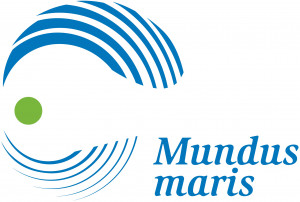The continuation of the campaign between July and October 2013 – Hann, Kayar and Saint Louis
Summary by Aliou Sall
The fishmongers operating at landing sites and markets in other sites (different markets in Dakar, landing sites in Mbour and Joal – see the beginning of the campaign here) had already told us that they value in principle the fish ruler (see facsimile below) with the indications to the minimum sizes of the most traded fish species. They also drew our attention to practical and administrative problems creating obstacles for daily application, such as the differences for one or two species between legal sizes and minimum sizes indicated on the ruler based on scientifically established precaution. For the continuation of this initial awareness campaign, it was imperative to capture wholesalers operating in other important fishing centres such as Hann, Kayar and St. Louis to complete the panorama of attitudes and concrete conditions. This is to better understand what may be realistically done to significantly reduce the capture and marketing of babyfish and ensure both the sustainability of the marine ecosystems and the companies operating in fishing and associated activities.
In Hann, Mr. Mbaye Rokh, working simultaneously at the Dakar Central Fish Market and at the landing site in Hann, introduced us to the fishmongers. In Kayar, we relied on Mr. Talla Gueye, a local development agent, Mundus maris partner and facilitator of ongoing initiatives involving fishmongers. Ms. Fatoumata Dièye, a student and volunteer facilitator for ongoing MM programmes in Senegal supported work in Kayar, while Mr. Assane Gueye helped us in Saint Louis. Given the intensity of activities at the landing sites and taking into account their respective vocations discussions were organised at this level of specificity as follows: First, with the facilitation of the focal point on site, we always started by recalling the objective of the mission. In this occasion the fish rules were demonstrated in practice. To put the fish ruler and its importance into a broader context, we explained the close relationship between this campaign for compliance with the minimum size of fish and one of the key principles of the ecosystem approach to fisheries (EAF). To recall, the five key principles are:
- maintain ecosystem integrity (fish species exist only in interaction with each other – no fish is an island)
- the precautionary approach to fisheries and any other use of marine and coastal ecosystems, while respecting the rules;
- ensure broad participation of different social actors;
- promoting sectoral integration and safeguarding livelihoods, and
- investment in research and knowledge.
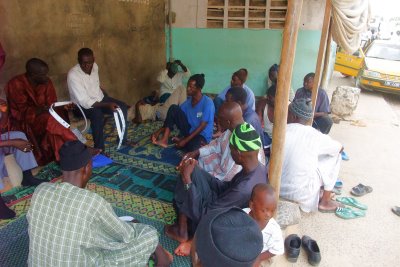
Then, on advice of the partner fishmongers, who have to their credit a long experience in the profession – an average of 30 years in the job, we worked along the existing marketing channel specialisations. The sub-sectors affected were:
- specialised in pelagic species and almost exclusively oriented towards supplying domestic markets for local consumption wholesalers, and
- the wholesalers specialised in trading with overseas markets (Europe and Asia in particular).
The work done at the various landing sites visited – while emphasising the value chain approach – led to the following conclusions: Fishmongers met in Hann, Kayar and St. Louis have identified a number of constraints and contradictions before applying the fish rulers. First, like their colleagues in Dakar, Mbour and Joal, they found out for themselves after probing that juveniles of the species on the fish ruler are captured and that the juveniles represent an important part in the composition of the landings. However, according to the fishmongers in Guet Ndar (Saint Louis) specialised in sardinella (Sardinella aurita) this fishery should be considered an exception to the rule. According to them, the size of the round sardinella caught in St. Louis is always greater than or at least equal to the size indicated on the fish ruler. This is attributed to exceptionally good conditions of the fishery. This information is well supported by fishers encountered in the area of hydrobase and by our own measurements in October 2013. This is a first fairly reassuring result. Only few specimens of the Lesser African Threadfin (Galeioides decadactylus) landed are juveniles and a significant number reaches the minimum size indicated on the fish ruler. This observation applies across different landing sites visited.
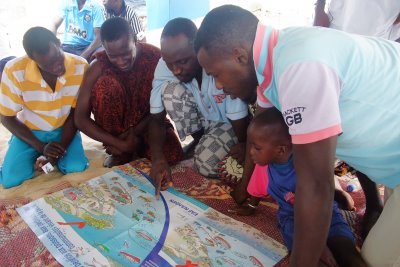
Apart from these two species, all others have, however, a very important part of juveniles in the landings by the artisanal fisheries. Given the number of baby fish landed in October 2013 as confirmed in the measurements of the Mundus maris team in the company of fishmongers, the situation is extremely worrying for the following species: Cassava croaker (Pseudotolithus senegalensis), catfish (Arius latiscutatus), Sompat grunt (Pomadasys jubelini) and white grouper (Epinephelus aenaeus). The fishmongers strongly believe it is time to harmonise regulatory framework in order to avoid planting and maintaining a lot of confusion between fishmongers from different sites, but also between fishmongers and administrative agents charged with representing the fisheries administration and ensuring enforcement of regulations. Indeed, the fishmongers think it is time to stop what they call „one weight, two measures“ to the extent that the Department of Fisheries allows different sizes e.g. for the sardinella, depending on the lobbies on the sites (for example different sizes are tolerated by the Department between Joal / Mbour and the rest of the landing sites). For the purpose of harmonisation, the wholesalers have also requested that the Department plays transparency with regional and international partners. They note that the sizes listed on the ruler, do not correspond to those reported by the fisheries administration. For example, for several species on the ruler, including the small sardinella, the fisheries administration works very officially with lower sizes than the precautionary ones adopted in the preparation of the fish ruler, when it was developed by Mundus maris in collaboration with local scientists, the Sub- Regional Fisheries Commission and FAO. Finally, another level where fishmongers challenge Mundus maris for better regulatory harmonisation between all stakeholders concerns the fact that the administration uses weight and not the length for legal limits. Thus, the correspondence is not always easy to establish. This is a relevant point to be addressed, even though it might be easier to determine the length using the ruler in field conditions that weigh the fish. It would therefore be advisable to harmonise the language and approaches so that the accepted need to save more small fish can be followed-up by concrete actions. Fishmongers met at the landing sites remain convinced that yet another major constraint is the urgent and compelling need to intervene in export markets and harmonise regulations between European and Asian markets. They fear that without such consensus, it will be difficult to save more baby fish. According to the fishmongers, profound changes are taking place in recent years in the external markets: Asian markets regained the hands of Europeans. The success of Asian operators is explained by many different factors, but particularly by:
- their informal nature, which facilitates their adaptation in an informal local economy
- the fact that the Asian market values all types of products. In the fisheries crisis when fishermen and fishmongers could not miss an opportunity to capture significant cash earnings from new products not consumed locally and paid in foreign currency, etc.
Thus the Mediterranean dealfish (Trachipterus trachypterus) marketed from 200 grams, has provoked a shift of fishing effort on the part of the fishers, as several Korean companies (factories) have recently set themselves up and specialised exclusively on this species. While continuing to take significant rents in these value chains, fishmongers denounce the Asian markets, which are demanding fish sizes below those traditionally destined for European markets.
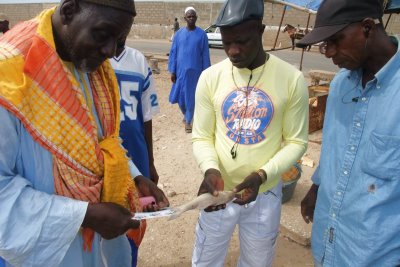
By way of a tentative conclusion:
The fish rulers proved as a useful entry point to raise awareness among fishmongers vis-à -vis the widespread problem of capturing and marketing juvenile fish. It helped to make this problem visible. It also brought to light a number of practical complications such as raised in meetings with the fishmongers. Meanwhile, the practice of capturing a lot of juveniles has already greatly damaged the productivity of the most valuable species and the entire ecosystem in Senegalese waters. However, strong demand from Asian markets such as Korea for species not traditionally targeted compensates at least in part for the loss of big-sized species and individuals, which are already overfished and which were intended for other export markets, including Europe. The exercise of quantitative reconstruction of real extractions (well beyond the reported catches) from Senegalese and neighbouring waters, which were recently presented by Dyhia Belhabib at the Mundus maris panel at the MARE conference in Amsterdam, deserves to be crossed with this first more qualitative look at changes in the markets (click here for info on this part of the work). The demand from local and external markets influence strongly the behaviour of local fishermen and fishmongers. Studying markets could help to better understand the recent changes raised by the fishmongers. The need to harmonise the regulations and their application also highlights the usefulness of strengthening the dialogue between different actors in order to create greater consensus on the issues and work towards solutions. Better communication of research results, via the fish ruler and by other means, should play an important role in the desirable and necessary adaptations for the future of the sector and the people who depend on it.
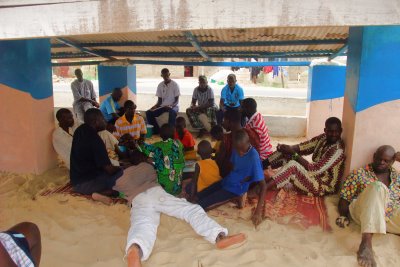
Meeresfrüchte, die wir essen
- World Food Day 2024, Joint Webinar with Fish Party
- UN-Sonderberichterstatter für das Recht auf Nahrung
- EP Hearing on EU Citizen Initiative to stop shark finning
- Keynote at the ‚Feed the Future – Innovation Lab for Fish‘
- FAO Webinar „Kleiner, preisgünstiger Fisch: Vom Köder zum Teller“, 15-16/02/2021
- Genießen Sie köstliche und nachhaltige Meeresfrüchte mit Mundus Maris Workshops
- Chiloé, oder: Die Katastrophen von Salmonopoly
- Seafood Symposium – From Fisheries to Foodies, 27 April 2015
- Baltic students concerned about sustainable foods, Rogow, Poland, 15-19 April 2015
- Vom Teller zum Sprit – der umstrittene Algenboom in Chile
- Khazan – traditionelle Bewirtschaftung der Küstengebiete in Goa, Indien
- Umweltbewusstes Konsumverhalten bei Lebensmitteln – was kann ich tun?
- Save baby fish or Point ’n‘ kill?
- „Unzertrennlich“ – Die Kampagne zur Nachhaltigkeit der Fischproduktion und des Konsums organisiert einen Event in Athen
- Respect for minimum fish size. What do Senegalese fish mongers have to say?
- The Mundus maris campaign in the urban markets in Dakar
- Let’s save the Oceans! – Cercle Europa invites
- International Study Group Brussels: Save the Seas!
- San Miguel Markt im Zentrum von Madrid
